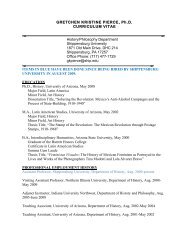Complete Issue - Shippensburg University
Complete Issue - Shippensburg University
Complete Issue - Shippensburg University
- No tags were found...
Create successful ePaper yourself
Turn your PDF publications into a flip-book with our unique Google optimized e-Paper software.
50 PROTEUS: A Journal of IdeasSometime before the middle of the first century,a modest shrine for Isis, an Egyptian import, wasestablished on the slope just south of the ArchaicSpring House beside an even smaller temple to thegoddess Themis.So, the original cult of the spring, followed by theArchaic round Spring House, later situated withinthe Asklepieion, or the sanctuary of Asklepios in theCity (cf. Plate 2) are very much older than the shrineof Asklepios, which was dedicated in 419/418 B.C. byTelemakhos of Acharnai, a devout private donor. 28 Thesacred territory of the spring was not officially markeduntil this last quarter of the fifth century, the era ofTelemakhos’s beneficence, when a marble boundarystone inscribed with the words horoskrenes (boundary of the spring) wasplaced, establishing the limits of theSpring House terrace.Asklepios owes his status andpopularity to the healing of sickness.His daughter who is named simplyHygieia (Health), also illustrates thehealing aspect. News of the miraclecures drew hordes of visitors toEpidauros, the home or original cultcentre of Asklepios (cf. Paus. 2.26,8),and gave rise to a regular healthbusiness. The worship of Asklepios,was introduced into Athens onthe occasion of the plague of 429B.C. According to the HistorianThucydides: “In the city of Athens it[the plague] appeared suddenly, and thefirst cases were among the populationof Piraeus, where there were no wellsat that time, so that it was supposedby them that the Peloponnesians hadpoisoned the reservoirs” (Thuc. 2.48).“Words indeed fail one when one triesto give a general picture of this disease; and as for thesufferings of individuals, they seemed almost beyondthe capacity of human nature to endure” (2.50). The“cure” followed a ritual, during which patients washedin the Sacred Spring, offered at an altar, and thenretired to the stoa (a porch or portico not attachedto a larger building) where the mysterious process ofincubation (egkoimēsis) was assisted by incense fromthe altars (cf. Paus. 2.27,1 f.). This ceremony and thereligious excitement it encouraged produced dreams,through which Asklepios was supposed to effect hiscure. Many ex-voto tablets to Asklepios and Hygieiahave been found showing the portion of the anatomytreated. These were affixed to a wall or were inlaid inthe columns; larger votive stelai, some showing the godvisiting sick patients in their sleep, were affixed to thestoa steps. The traveller and writer, Pausanias, living inthe second century A.D., recounted the votive offeringshe saw while visiting the Acropolis cave (1.21,4-7).Plate 7: One of the impatientguards workng at the Acropoliswithin the church dedicated tothe Life-giving Spring (authorphotograph)He specifies (1.21,4): “In it there is a spring, by whichthey say that Poseidon’s son Halirrhothios (Seafoam)deflowered Alkippe the daughter of Ares ….”The baths were important in the shrines ofAsklepios, since the ancient Greeks believed Asklepioswould not accept or come into personal contact withpatients who had not been washed. Accordingly,sacred springs are mentioned in all three hundredtwenty documented Asklepieia. 29 The clear bubblingwater of a spring, rising out of the earth by a power,habitually regarded as a water nymph, was, in theimagination of the ancient Greeks, a gift of the waterdeities, the goddesses by which all life on earth wasfed. 30 Accordingly, it is quite understandable thateven pure water was considered tohave therapeutic properties. Ancientmedicine employed water treatmentsin various ways for a great varietyof maladies including eczema,rheumatism, gout, and psychosomaticdisorders. The physician, Galen(approximately A.D. 129-199) gavedetailed instructions for particularwater treatments, which took place inPergamon in Asia Minor.In the fifth or the beginningof the sixth century A.D., all thebuildings were demolished and onthe foundations a large three-aisledChristian basilica was built to thememory of Ag. Anargyroi, thepatron saints of healing. 31 Whenearly Christians built a structure onthe remains of the Asklepieion, thesanctuary dedicated to the ancientgod of healing became a ByzantineChurch. Here, under the patronage ofAg. Kosmas and Ag. Damianos (i.e.Ag. Anargyroi), many of the healingtraditions of the ancients continued under the cloak ofChristianity. When the area around the Asklepieionwas excavated in 1876, the cave with holy water alsobecame dedicated to the Panagia. 32Some scholars have emphasized the continuities inthe cults of male divinities at the site—first the pagan,Asklepios, and then the Christian, Ag. Anagyroi. 33In the practical rituals of contemporary locals,however, the female Panagia has emerged as the mostimportant saint. In antiquity, the two Acropolis caveswere dedicated to the water nymphs and Artemis 34respectively, and later they became churches wherethe Panagia is worshipped. In other words, in the twocaves there have been cults dedicated to female fertilityand healing divinities in ancient (i.e. archaic) andmodern times, even if the names of the divinities havechanged. The male elements in the Classical (Asklepiosand Dionysos respectively, Asklepios neverthelesstogether with Hygieia) and the Byzantine periods
















